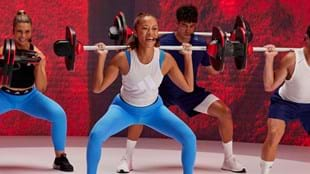What's the ideal squat depth?
During a BODYPUMP™ workout, the ideal squat range is 90 degrees of knee flexion. Although range variations are utilized within the workout, the full range 90-degree squat is the predominant depth.
However, there's often an undetected discrepancy in this 90-degree range. If you’re consistently squatting shallower than 90 degrees, you could be missing out on the extra drive required to achieve this depth, along with the positive training effects it brings.
Why should I squat to 90 degrees?
Research examining the effects of both depth and load in BODYPUMP participants proposed that squatting to 90 degrees causes a higher than average and peak muscle activation of your glute max and vastus lateralis quad muscle. The researchers also discovered that peak activation of your main hamstring muscle and lateral calf muscle increased when squatting to this range.
Additional biomechanical studies have supported these findings, showing higher muscle activations of similar muscles when squatting to 90 degrees, compared with other depths. This is thought to be largely due to the ‘sticking point’ or ‘sticking region’ created at 90 degrees of knee flexion. At this point, the load of the bar is at its furthest from the knee, creating a mechanical disadvantage which essentially means it requires more force to be created by your muscles to be moved back up again.
This is why we see the highest muscle activation of the muscles moving the knee joint, such as the quads, in this part of the range. The glutes — the primary drivers of the hips in the squat — kick in extra hard here, and we see very high activity in them as they help the quads out through the toughest part of the squat. This part of the squat should feel the hardest as it's the most demanding. You will often hear coaching focusing on squeezing and driving the glutes from the bottom of the squat to encourage you to work at this depth effectively and consistently.
How can I achieve this range?
Firstly, I encourage you to closely observe your own squatting range and feel the difference demanded by the different depths. If you can squat to 90 degrees or lower with just your bodyweight, it’s likely you don’t have any mobility restrictions preventing this range and it might just be a case of consciously increasing your depth.
During a BODYPUMP workout, the slower squat tempos like 4/4 are a great opportunity to hit this depth as there's plenty of time to reach it. Technique-wise, shifting the hips back and down should help you reach the 90-degree range and reduce the likelihood of overloading the knees.
With the above findings in mind, hitting the 90-degree range may enhance results, strength gains and intensify that BODYPUMP feel. Taking note of your own range and ensuring you’re hitting the depth is a good place to start before adding load.
What's the ideal squat weight to lift during BODYPUMP?
Following the advice of doubling your warm-up weight if you’re new, or increasing it by 2-4 times if you’re advanced, should land you on the ideal weight.
This has been specifically designed to allow you to maintain the pace of the class and keep you in the strength endurance training realm. Adding too much weight is essentially self-limiting — an ingenuity of the BODYPUMP choreography! Everyone has a different relative strength so finding your own sweet spot is key. You don’t want to be going to absolute failure or fatigue.
On average there are 99 squat repetitions per class and research data tells us we see the average load at around 20-25% of a one-rep maximum.
In terms of muscle activation, research performed on BODYPUMP loads on a participant group indicates that adding load will increase the average and peak activity of your glute max in particular. This means making small incremental additions to your load while remaining within the guidelines could increase your training effects.
If you’re new to the workout, it's likely you'll be able to add load as you do more workouts and adapt to the training. If you’re a more advanced BODYPUMP participant, you may have plateaued with your load, having already made a lot of adaptations in response to the training.
In summary, take time to notice the consistency of the depth of your squat during each workout. Your goal is to keep up with the repetitions set to the music and hit the 90-degree range throughout the track. You should perform the workout with weights that allow you to do so. If you’re making additions to your load, do so incrementally, ensuring you can maintain the range and timing of the workout.
What does that mean for my coaching?
As an Instructor, coaching the 90 degree squat range is enhanced by accurately demonstrating this range to participants. Understanding the aforementioned benefits of squatting to 90 degrees can add authenticity to Layer 2 cueing, timing and education-based extrinsic cues.
I encourage Instructors to evaluate their own squat depth during class and ensure they role-model the full 90 degree range on stage.
3 Squat drills to save your knees
Discover three quick and easy drills that will help you squat better while protecting your knees.
Rob Lee is a Les Mills Technical Consultant, Coach and Research Manager. He is an internationally experienced physiotherapist, having worked in professional sports, private practice, and many high-performance training environments. Combined with his competitive training background, Rob has a passion for creating effective exercise to benefit people’s health, no matter their ability. "With the right environment, program, and guidance, people will always achieve more than they think they’re capable of.”







